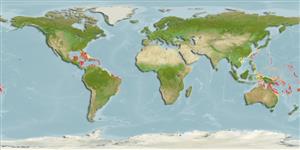Demospongiae |
Agelasida |
Agelasidae
Environment: milieu / climate zone / djupintervall / distribution range
Ekologi
; djupintervall 2 - 61 m (Ref. 108813). Tropical
Western Atlantic and Western Central Pacific.
Length at first maturity / Size / Weight / Age
Könsmognad: Lm ? range ? - ? cm Max length : 10.0 cm OT hane/ej könsbestämd; (Ref. 415)
Massive; flabellate; rising from a narrow base: 1.5 - 10 cm thick. Bright red-orange externally, lighter internally. The margin is rounded, or indented. Compressible, resilient. The surface is rough to be touch to verrucose, with abundant membrane-bearing oscula: 0.2 - 0.5 cm in diameter (Ref. 415). Color range from orange to brown (Ref. 81728).
Maximum thickness: 10 cm (Ref. 415). Maximum depth reported taken from Ref. 128739. Found in coral reefs, usually below 10 m in depth (Ref. 415), and on rocky bottoms (Ref. 83912). It hosts alpheid shrimps, i.e., Synalpheus spp. in its canals (Ref. 86672). Inhabits shallow and mesophotic coral reefs along with coral communities and coralline algae reefs (Ref. 128739).
Life cycle and mating behavior
Könsmognad | Reproduktion | Lek | Eggs | Fecundity | Larvae
Members of the class Demospongiae are hermaphroditic. Life cycle: The zygote develops into parenchymella larva (free-swimming) before settling down on a substrate where it grows into a young sponge.
Collin, R., M.C. Díaz, J. Norenburg, R.M. Rocha, J.A. Sánchez, M. Schulze, A. Schwartz and A. Valdés 2005 Photographic identification guide to some common marine invertebrates of Bocas Del Toro, Panama. Caribbean Journal of Science. 41(3):638-707. (Ref. 415)
IUCN Red List Status
(Ref. 130435: Version 2025-1)
CITES status (Ref. 108899)
Not Evaluated
Not Evaluated
Threat to humans
Harmless
Human uses
| FishSource |
Verktyg
Ytterligare information
Trophic EcologyFood items (preys)
Födosammansättning
Födointag
Predatorer
Population dynamicsTillväxt
Max. ages / sizes
Length-weight rel.
Length-length rel.
Length-frequencies
Mass conversion
Abundans
PhysiologySyreförbrukning
Human RelatedStamps, coins, misc.
Internet-källor
Estimates based on models
Preferred temperature
(Ref.
115969): 26 - 28.3, mean 27.2 (based on 435 cells).
Fishing Vulnerability
Low vulnerability (10 of 100).
Price category
Unknown.
